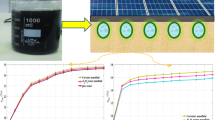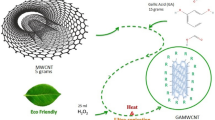Abstract
The main objective of current work is to scrutinize the performance of unglazed photovoltaic thermal system (PVTs) and transparent glazed photovoltaic thermal system (GPVTs) from energy and exergy standpoints using four different operating fluids consisting of deionized water, GNP/water, SWCNT/water, and MWCNT/water nanofluids with a mass concentration of 0.05%. Sunny and stable days with the clear sky of September and October are selected as the suitable actual conditions. The outdoor experiments are carried out from 9:30 to 16:00. The results reveal that in the GPVTs, although using a transparent glass cover has an undesirable effect on the surface temperature, electrical output power, and electrical efficiency, the concurrent effect of the glass cover and nanofluid considerably increases the thermal and overall efficiencies. Among all studied operating fluids, the GNP/water and SWCNT/water nanofluids would be more efficient in terms of energy and exergy performances. Regarding the energy viewpoint, the overall efficiencies of GPVTs/MWCNT, GPVTs/SWCNT, and GPVTs/GNP are higher by 12.32%, 17.02%, and 22.65%, respectively, compared to those of PVTs with deionized water. Moreover, from the exergy viewpoint, the overall efficiencies of PVTs/water, PVTs/MWCNT, PVTs/SWCNT, and PVTs/GNP are higher by 1.42%, 1.68%, 1.93%, and 2.32%, respectively, compared to those of the PV unit.












Similar content being viewed by others
Abbreviations
- A :
-
Area/m2
- C p :
-
Specific heat capacity/J kg−1 K−1
- \(\dot{E}\) :
-
Energy rate/W
- \({\dot{\text{E}}\text{x}}\) :
-
Exergy rate/W
- \({\text{FF}}\) :
-
Filled factor
- \(\dot{G}\) :
-
Solar radiation rate/W m−2
- \(I\) :
-
Electrical current/A
- \(\dot{m}\) :
-
Mass flow rate/kg s−1
- \(T\) :
-
Temperature/K
- \(V\) :
-
Electrical voltage/V
- \(\alpha\) :
-
Absorptivity of panel
- \(\eta\) :
-
Energy efficiency/%
- \(\varepsilon\) :
-
Exergy efficiency/%
- \(\rho\) :
-
Density/kg m−3
- \(\phi\) :
-
Volume concentration
- \(\tau\) :
-
Glass cover transmissivity
- Amb:
-
Ambient
- Bf:
-
Base fluid
- C:
-
Collector
- Cell:
-
Photovoltaic cell
- Dest:
-
Destruction
- El:
-
Electrical
- F:
-
Fluid
- G:
-
Glass cover
- In:
-
Input
- N:
-
Nanoparticle
- Oc:
-
Open circuit
- Outlet:
-
Outlet
- Sc:
-
Short circuit
- Th:
-
Thermal
- PV:
-
Photovoltaic unit
- PVTs:
-
Photovoltaic thermal system
- GPVTs:
-
Photovoltaic thermal system with a glass cover
References
Amini M, Kianifar A, Edalatpour M, editors. An analytical study on energy and exergy of a minichannel-based solar collector using Fe3O4 and MgO/water nanofluids. In: International conference on researches in science and engineering; 2016.
Ammar AA, Sopian K, Alghoul MA, Elhub B, Elbreki AM. Performance study on photovoltaic/thermal solar-assisted heat pump system. J Therm Anal Calorim. 2019;136(1):79–87. https://doi.org/10.1007/s10973-018-7741-6.
Kazemian A, Salari A, Hakkaki-Fard A, Ma T. Numerical investigation and parametric analysis of a photovoltaic thermal system integrated with phase change material. Appl Energy. 2019;238:734–46. https://doi.org/10.1016/j.apenergy.2019.01.103.
Gangadevi R, Vinayagam BK. Experimental determination of thermal conductivity and viscosity of different nanofluids and its effect on a hybrid solar collector. J Therm Anal Chem. 2019;136(1):199–209. https://doi.org/10.1007/s10973-018-7840-4.
Hossain MS, Pandey AK, Selvaraj J, Abd Rahim N, Rivai A, Tyagi VV. Thermal performance analysis of parallel serpentine flow based photovoltaic/thermal (PV/T) system under composite climate of Malaysia. Appl Therm Eng. 2019. https://doi.org/10.1016/j.applthermaleng.2019.01.007.
Khanna S, Newar S, Sharma V, Reddy KS, Mallick TK, Radulovic J, et al. Electrical enhancement of solar photovoltaic using phase change material. J Clean Prod. 2019. https://doi.org/10.1016/j.jclepro.2019.02.169.
AL-Musawi AIA, Taheri A, Farzanehnia A, Sardarabadi M, Passandideh-Fard M. Numerical study of the effects of nanofluids and phase-change materials in photovoltaic thermal (PVT) systems. J Therm Anal Calorim. 2019;137(2):623–36. https://doi.org/10.1007/s10973-018-7972-6.
Fudholi A, Zohri M, Rukman NSB, Nazri NS, Mustapha M, Yen CH, et al. Exergy and sustainability index of photovoltaic thermal (PVT) air collector: a theoretical and experimental study. Renew Sustain Energy Rev. 2019;100:44–51. https://doi.org/10.1016/j.rser.2018.10.019.
Kumar R, Rosen MA. A critical review of photovoltaic–thermal solar collectors for air heating. Appl Energy. 2011;88(11):3603–14. https://doi.org/10.1016/j.apenergy.2011.04.044.
Preet S. Water and phase change material based photovoltaic thermal management systems: a review. Renew Sustain Energy Rev. 2018;82:791–807. https://doi.org/10.1016/j.rser.2017.09.021.
Yazdanifard F, Ameri M, Ebrahimnia-Bajestan E. Performance of nanofluid-based photovoltaic/thermal systems: a review. Renew Sustain Energy Rev. 2017;76:323–52. https://doi.org/10.1016/j.rser.2017.03.025.
Aberoumand S, Ghamari S, Shabani B. Energy and exergy analysis of a photovoltaic thermal (PV/T) system using nanofluids: an experimental study. Sol Energy. 2018;165:167–77. https://doi.org/10.1016/j.solener.2018.03.028.
Al-Waeli AHA, Chaichan MT, Kazem HA, Sopian K. Comparative study to use nano-(Al2O3, CuO, and SiC) with water to enhance photovoltaic thermal PV/T collectors. Energy Convers Manag. 2017;148:963–73. https://doi.org/10.1016/j.enconman.2017.06.072.
Sardarabadi M, Hosseinzadeh M, Kazemian A, Passandideh-Fard M. Experimental investigation of the effects of using metal-oxides/water nanofluids on a photovoltaic thermal system (PVT) from energy and exergy viewpoints. Energy. 2017;138:682–95. https://doi.org/10.1016/j.energy.2017.07.046.
Said Z, Arora S, Bellos E. A review on performance and environmental effects of conventional and nanofluid-based thermal photovoltaics. Renew Sustain Energy Rev. 2018;94:302–16. https://doi.org/10.1016/j.rser.2018.06.010.
Fayaz H, Nasrin R, Rahim NA, Hasanuzzaman M. Energy and exergy analysis of the PVT system: effect of nanofluid flow rate. Sol Energy. 2018;169:217–30. https://doi.org/10.1016/j.solener.2018.05.004.
Nasrin R, Rahim NA, Fayaz H, Hasanuzzaman M. Water/MWCNT nanofluid based cooling system of PVT: experimental and numerical research. Renew Energy. 2018;121:286–300. https://doi.org/10.1016/j.renene.2018.01.014.
Abdallah SR, Saidani-Scott H, Abdellatif OE. Performance analysis for hybrid PV/T system using low concentration MWCNT (water-based) nanofluid. Sol Energy. 2019;181:108–15. https://doi.org/10.1016/j.solener.2019.01.088.
Alshaheen AA, Kianifar A, Rahimi AB. Experimental study of using nano-(GNP, MWCNT, and SWCNT)/water to investigate the performance of a PVT module. J Therm Anal Calorim. 2019. https://doi.org/10.1007/s10973-019-08724-5.
Alous S, Kayfeci M, Uysal A. Experimental investigations of using MWCNTs and graphene nanoplatelets water-based nanofluids as coolants in PVT systems. Appl Therm Eng. 2019;162:114265. https://doi.org/10.1016/j.applthermaleng.2019.114265.
Yazdanifard F, Ebrahimnia-Bajestan E, Ameri M. Investigating the performance of a water-based photovoltaic/thermal (PV/T) collector in laminar and turbulent flow regime. Renew Energy. 2016;99:295–306. https://doi.org/10.1016/j.renene.2016.07.004.
Chow TT, Pei G, Fong KF, Lin Z, Chan ALS, Ji J. Energy and exergy analysis of photovoltaic–thermal collector with and without glass cover. Appl Energy. 2009;86(3):310–6. https://doi.org/10.1016/j.apenergy.2008.04.016.
Kazemian A, Hosseinzadeh M, Sardarabadi M, Passandideh-Fard M. Effect of glass cover and working fluid on the performance of photovoltaic thermal (PVT) system: an experimental study. Sol Energy. 2018;173:1002–10. https://doi.org/10.1016/j.solener.2018.07.051.
Said Z, Saidur R, Sabiha MA, Rahim NA, Anisur MR. Thermophysical properties of Single Wall Carbon Nanotubes and its effect on exergy efficiency of a flat plate solar collector. Sol Energy. 2015;115:757–69. https://doi.org/10.1016/j.solener.2015.02.037.
Haddad Z, Abid C, Mohamad AA, Rahli O, Bawazer S. Natural convection of silica–water nanofluids based on experimental measured thermophysical properties: critical analysis. Heat Mass Transf. 2016;52(8):1649–63. https://doi.org/10.1007/s00231-015-1682-4.
Drew DA, Passman SL. Theory of multicomponent fluids. Berlin: Springer; 2006.
Kazemian A, Hosseinzadeh M, Sardarabadi M, Passandideh-Fard M. Experimental study of using both ethylene glycol and phase change material as coolant in photovoltaic thermal systems (PVT) from energy, exergy and entropy generation viewpoints. Energy. 2018. https://doi.org/10.1016/j.energy.2018.07.069.
Hosseinzadeh M, Sardarabadi M, Passandideh-Fard M. Energy and exergy analysis of nanofluid based photovoltaic thermal system integrated with phase change material. Energy. 2018;147:636–47. https://doi.org/10.1016/j.energy.2018.01.073.
Author information
Authors and Affiliations
Corresponding authors
Additional information
Publisher's Note
Springer Nature remains neutral with regard to jurisdictional claims in published maps and institutional affiliations.
Amin Taheri and Mohsen Kazemi have equal contribution in this work as the first author.
Rights and permissions
About this article
Cite this article
Taheri, A., Kazemi, M., Amini, M. et al. The performance assessment of nanofluid-based PVTs with and without transparent glass cover: outdoor experimental study with thermodynamics analysis. J Therm Anal Calorim 143, 4025–4037 (2021). https://doi.org/10.1007/s10973-020-09311-9
Received:
Accepted:
Published:
Issue Date:
DOI: https://doi.org/10.1007/s10973-020-09311-9




